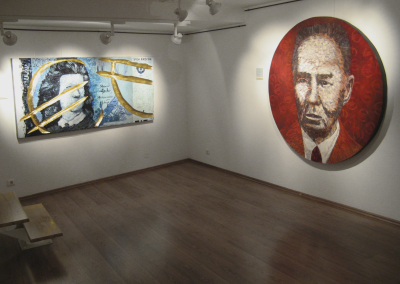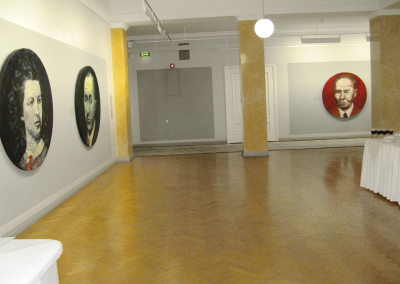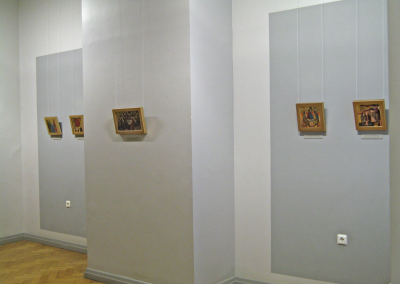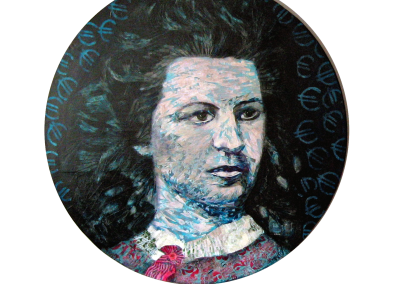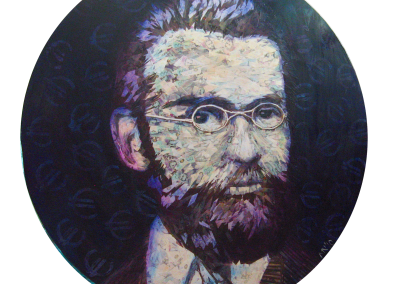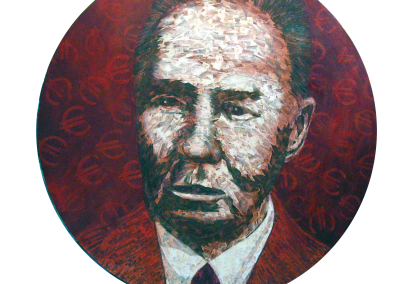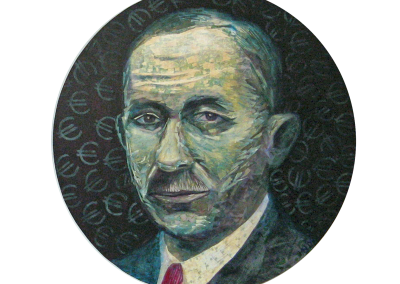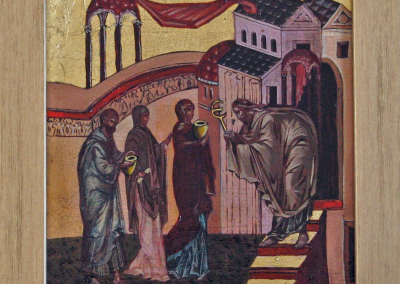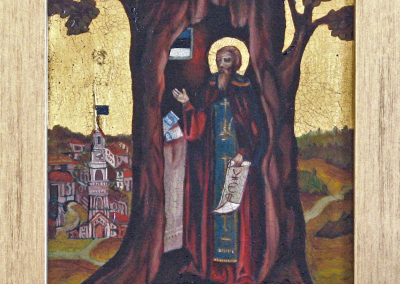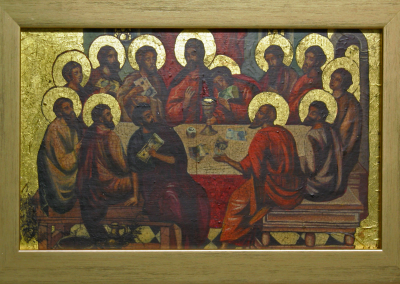„Money Faces”, „Money Faces II“
„Money Faces“, 2010, Haus Gallery, Tallinn
„Money Faces II“, 2010, Parliament Gallery, Tallinn
Claws of Euro in the Face of Crown
Mall Nukke’s exhibition „MoneyFaces“ at Haus Gallery (until 17 September 2010).
Money motivates us to work as ineffectively as a floating straw will help us swim. Money is merely the thing that helps us keep afloat. When a swimmer finds himself drowning (much to his horror), he is ready to grab anything, even a straw to stay above the water. However, something must have motivated him to get into the water in the first place. Maybe he wanted to cool himself down or maybe he just enjoys getting wet. Maybe he was inspired by the straw floating on the water.
Something motivated the artist, to paint. Maybe painting helped to calm his nerves or maybe he enjoys the smell of varnish. Maybe he was inspired by a banknote in the gutter.
That’s where the Estonian kroon is heading, into the gutter. We overestimate the motivating power of money, but underestimate its power to inspire. If people had thought more about money and its role in society, we would not be in this current economic crisis; we would understand ourselves and the State better and we would not have allowed money to supersede other values. Maybe then we would not be ruled by king Midas. Whatever they touch, wherever they sneeze everything turns to money, which then slips through their fingers into circulation. Stories are told that somewhere money accumulates to form banks and whoever goes to withdraw money gets their hand stuck, much like Kalevipoeg’s fist, which became stuck in the rock when he pounded on the doors of the underworld. That’s how he became immortal.
To banks we [the clients] are ever present – we are like single cells in a large body. When one client disappears, another one replaces him and the overall change to the bank is tiny – one bank account number is just replaced by another, in the same way as cells are replaced in the body. However, the body and its circulation of blood/money still exists. Now in the face of the impending currency reform, there is a feeling in the air that somebody is about to drain our unique and original Finno-rhesus Ugric-positive blood and replace it with E-negative blood. Or maybe the gargantuan EU will have mercy on us little leeches, who without the help of a donor cannot produce enough blood, and let us hang on to its strong back. Well, this is also a form of immortality.
However, we are not immortal. Money, which Siim-Tanel Annus referred to with the historic samples of kroons, rubles and marks on his painted reliefs depicting banknotes, is not immortal either. We are living human beings made of flesh and blood and we want to use the time we have as constructively as possible. We want to learn to understand ourselves and the world before we have to leave it. We want to take our cue from our cultural icons and leave behind something of ourselves as well.
The Euro has definitely left its mark on Mall Nukke’s painting of the 100 kroon banknote. It looks as if a Euro paw has scratched Lydia Koidula’s face with its golden claws. While Siim-Tanel Annus built his painting reliefs on canvas with thick lines of paste, Mall Nukke has cut deep lines into the surface with the help of ‘Euro claws’. As an icon painter she sees hidden meaning in colour. Blue is not only the colour of Koidula’s denomination, but it is also the colour of light which disappears into the dark because blue appears black in the dark. Gold on the other hand is the colour of darkness, because it stands out in the dark.
In the fight between the poet and the financial wolf, between light and darkness, the artist’s support clearly belongs to Koidula. “The idea is simple – it’s either the power or the spirit?” writes Mall Nukke in the accompanying text for the exhibition. “I have always felt drawn to narratives. In this case the options are: money or culture. These two have never been a credible match. What has the world of money got to do with the world of culture? Maybe the faces of the poets, artists, writers and visionaries that are depicted on banknotes are the only connection there is. The ties between the people in those professions and the world of finance have always been complicated or non-existent.”
Mall Nukke’s exhibition is composed of small icons and huge paintings. We have already described the “scratched” 100 kroon banknote; other large images depict (in collage form) Kristjan Raud, Anton Hansen Tammsaare, Lydia Koidula and Carl Robert Jakobson.
Mall Nukke’s cartoon icons depict Estonian legends about money. People crying over a coffin turn into people cheering at a dice game. Of course the winners are those who bet on the Euro. A Euro church is built in the middle of a village and there is an Estonian flag in one corner showing a hermit living in a tree trunk. Under it there is a chest full of Koidula’s denominations. It is difficult to distinguish between the sacredness and the mockery in these works. But Saint Kristjan, Saint Anton Hansen, Saint Lydia and Saint Carl Robert have been portrayed with a spirituality that is usually reserved for icons. With the exception of Kristjan Raud, the main colour of their denomination has been used to depict each of them. However, Nukke has used strong red to draw attention to her colleague. These collages have been composed of cut pieces of paper. Sharp angular cuts have added a seemingly inbuilt gloom and give an edgy touch to the faces. On the other hand, the way that Nukke has shaped the faces of these cultural figures gives them a soft and sympathetic look.
In addition to what has already been mentioned, Estonian banknotes are actually very pretty, unlike the Euros that demonstrate lame examples of architecture which go well with the geometry of the hallways of bureaucracy and the arithmetic of accounting charts.
However, looking at the issue from another angle: have the people in finance learned anything in the past few decades about the cultural figures that used to be on our banknotes? Have they understood that they were not paid for their music, that they had trouble subsisting and that many of them lived off the generosity of others? Have the finance folk learned to appreciate the gifts they received from the cultural folk – gifts that become public property without taxes, without purchase agreements in tiny scripts and without the services of lawyers? Have the cultural folk understood that anybody can print money and that the money train can be pulled by a huge team of burlaks of culture, but that the carriages are nevertheless led and rails put down by those whose signatures are on the banknotes? For economic bureaucrats a boring building that no one cares about is a more honest mask than the face of a poet, with a wreath of laurels on his head.
However, there is still hope that the Euro claw will not rip off the mask but will decorate the curls of the poet like an alien orchid who is welcomed into the local family of orchids. Only then will it be clear what must be given to the emperor, because it belongs to the emperor, and what must be given to the people, because it belongs to culture. And then the laurels that give up their place on the head of the poet to the Euro blossom can make their way to the soup pot.
Andri Ksenofontov
Sirp, 17. 09. 2010

